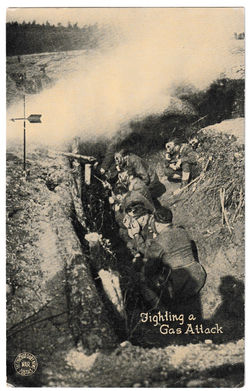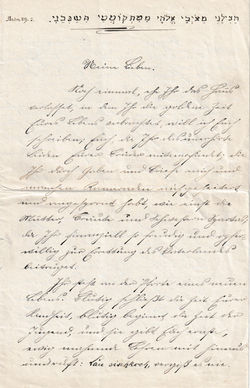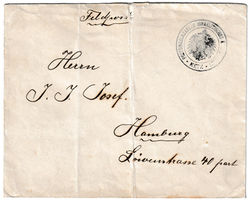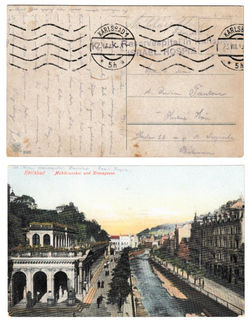top of page
THE WESTERN FRONT
Serbian assassination of the heir to the Austro-Hungarian throne led to war. Through interlocking alliances, most of Europe was drawn in. Austria-Hungary, Germany, and later Turkey formed the 'Central Powers'. Their leaders and flags are shown on this postcard, including Bulgaria on the right. Their slogan - 'One Spirit, One Arm, One Will'.
The Western Front was the main theatre of war. The German Army opened the Western Front by invading Luxembourg and Belgium, then gaining military control of important industrial regions in France. Both sides dug in along a meandering line of fortified trenches, stretching from the North Sea to the Swiss frontier with France, which changed little. Entrenchments, machine gun emplacements, barbed wire and artillery inflicted more than 2,000,00 casualties.
To break the deadlock of trench warfare on the Western Front, both sides tried new military technology, including poison gas, aircraft, and tanks.
 West.Central Powers PCThe Central Powers. Serbian assassination of the heir to the Austro-Hungarian throne led to war. Through interlocking alliances, most of Europe was drawn in. Austria-Hungary, Germany and later Turkey formed the Central powers. Their leaders and flags are shown on this postcard, with Bulgaria on the right. Their slogan: 'One Spirit, One Arm, One Will'. |  Allied PowersOn July 28, 1914, Austro-Hungary, supported by Germany, declared war on Serbia. On August 1 Germany declared war on Russia, and two days later on France. Britain, France's ally, declared war on Germany on August 4, 1914. The Great War was on. This card shows the soldiers and flags of the Allied Powers - Britain, France, Russia, and Belgium. |  Battle of Dicksmuide, BelgiumGermany invaded Belgium in August 1914, intending to quickly control France and then focus on Russia to the East. In October they reached Dicksmuide and encountered fierce resistance. Also known as the Battle of Yser river. The postcard pictures the battle 'Against French, British, & Belgians'. It was sent from the battle-field to New Jersey in March 1915. The back shows the imprint of his regiment. |
|---|---|---|
 German soldier in BelgiumGerman Jew wounded at Dicksmuide. Writing from Dusseldorf (Germany) to his parents in Jerusalem !, this soldier reports: "I came here with a head wound I received at Dixmuide where we violently fought against British, French, Belgians. In a few days I should be able to return to the front... Your son Friedrich". Mailed 25 October 1914 to Paramedic Dr. Einsler, Jerusalem, Turkey. |  German soldier.photoGerman Jewish Soldier. Friedrich Einsler's postcard to his parents was actually a photo of him on the other side, wearing his military uniform. |  Argonne France BattleForest of Argonne. This forest, east of Paris, became the site of intense fighting between German and Allied units in 1914, 1915 and autumn 1918 when a 47 day battle helped end the war, causing well over 50,000 dead. This card was mailed from the field in March of 1915, to New Jersey USA. |
 German Bayonet ChargeThis Chicago Daily News photo card illustrates "A German Charge with Fixed Bayonets". The caption says it is a photo taken from the American lines in France. How fearsome a sight to behold and one can imagine the gory results of two such armies clashing. |  Gas and TrenchesTrench warfare had been used for centuries. It reached its peak in WWI, with both sides digging in and making their outposts almost impenetrable. Poison gas was introduced by the Germans successfully in 1915 in France and soon all sides were using it which led to the development of gas masks. On this card we see Americans in their trenches experiencing a gas attack. Gas masks are in place & a weathervane helps them determine which way the wind is blowing. The 1st weapon of mass destruction. |  Tank WarfareHere come the Tanks. Trench warfare at the Western front was at a stalemate. The British pioneered the use of tanks, at the battles of Somme. Soon the French followed. These could reach and overcome trenches, the armor immune to machine guns. In this battle scene, troops accompany the tank and charge the enemy. |
 German Army Service RecordThis is the army service record of Walter Furth. Born 25 Feb 1899, mother's maiden name Katzenstein, religion ISR(raelite). He entered the army in June 1917 in the foot artillery 3rd battalion. Good behavior. Injured in battle in November, transferred to a convalescent center in Roye France. Honorably discharged 16 May 1919. Pension initiated. |  German Jewish Chaplain ItalienerAbout 30 Jewish chaplains served in the German army in WWI. They arranged services, visited field hospitals, helped with correspondence, arranged burials and distributed packages. Liberal Rabbi Dr. Bruno Italiener b. 1881 served from 1914 - 18 with the 7th army on the Western front. He typed this field postcard to the Posen family dated March 1916. "I saw your son at the recent prayer service. He is healthy and happy. May G-d protect him.... Field Rabbi Italiener Army Command 7. |  'Gifts of Love'Soldier Ehrmann writes from the field at Soignies, Belgium, which was the sight of the first battle of British troops against Germany (in August). He addresses the 'Gifts of Love' committee at the Hamburg Talmud Torah high school, class IVB. These gifts were care- packages sent from families to troops at the front, usually delivered by the chaplains. In this case it was a Jewish school that put together packages for Jewish (and other) soldiers. Mailed 21 December 1914. |
 Dedication to GraduatesInspiration from the field. This carefully drawn design shows a Magen David and inside it a hand holding a German flag, showing Jewish German patriotism. It decorates an inspirational message to graduating students in Hamburg. It was created by Sam Wurzburg, who signs it "In the field, 31 March '16 in France". It reads "Dedication - on the 1st class as they leave school". |  save me From my EnemiesAbove the message is written in careful Hebrew הצילני מאויבי אלקי, ממתקוממי תשגבני. A quote from Tehillim / Psalms 59:2 where David prays 'Save me from my enemies my G-d'. The message could be a graduation speech and displays great patriotism. "You are standing at the portal of your life...bloody is the beginning...Don't forget that with David's shield we fought and held the flag that is dear to us...we are unified therefore we can be victorious...May you experience only joy. |  Message From the FrontThe Higher Jewish girls School. "We are fighting because we are Jews and Germans...for the right of Germany the honor of Jews and the well-being of mothers and sisters and the future of a young new generation... may our work be crowned by a long and victorious peace. |
 Jewish field HospitalMetz Jewish field Hospital. Metz is in French Lorraine, at the meeting point with Germany and Luxembourg. This undated envelope appears to be from this period. It is marked 'Feldpost' and the impression reads: 'Fortress Hospital Jewish...". Apparently a field hospital catering to Jews? |  German Jewish Chaplain BaerwaldLeo Baerwald b. 1883 served in the army as a soldier and then 'Field-Rabbi' (chaplain) from August 1914 to October 1917. He was attached to the Bavarian 6th Army. He supplied this 'War Memorial Card' to soldiers with his imprint. This one was mailed from Lille, France in February 1916, close to the Belgian frontier. The picture on the card shows a bombed-out street in Lille. "Thanks for your wishes. Greetings to you and your family." |  German POW in FranceJewish soldier Wilhelm Buchlos is held as a prisoner of war by the French at Le Havre camp. He writes to cousin Martha Stern in Wurzburg in April 1916. "As yet did not receive your letter...the money also did not arrive. I'm asking you to intervene with the Red Cross...My brothers don't write to me...All the best for 'Easter' (= Passover)." Postmarked at Le Havre and censored by the POW administration. |
 German POW at MarseillePOW Friedrich Lanzky, held as a prisoner of war by the French at Marseille, sent this envelope home to Helene Lanzky in Hirschburg Germany. There is no stamp or date but we see the imprint of the pow camp censor in the corner. The number of POWs held by all the sides reached into the millions in the course of the war. |  POW held by EnglandSent from Stockholm Sweden 21 Dec 1917, this card was addressed to German Jewish musketeer Fritz Rosenbaum, a POW held in Surrey England. It was returned to sender with a label reading "This POW has died". "Dear Fritz, we don't know how you feel and what is wrong with you...we sent you money...You must write your mother telling her what is ailing you...I wish you a rapid strengthening". |  Destroyed synagogues in FranceGermany reached the French province of Lorraine in August 1914 and began shelling cities. They shelled Rheims for 4 years, destroying every significant building in the city and killing 5000 residents. Here we see the effects upon the local synagogue in Reims and another in the city of Luneville. |
 Thann Synagogue DestroyedThann is another town in north-east France that was subject to shelling by the Germans. These postcards show what the synagogue looked like before the shelling and the ruined remains afterwards. The caption reads: 'Bombardment of 19 January 1915'. |  General Monash stampAustralian John Monash was a highly educated Dr. of Engineering when he volunteered for military service. His successes in France in 1918 led to the collapse of the German front. He was later an active synagogue member and Zionist. Australians founded a moshav in Israel in 1946 and named it Kfar Monash in his memory. |  Prisoner of War SynagogueBy 1915, Germany held over a million POWs. Some were kept in a POW camp in Doberitz, Germany, west of Berlin. They were Belgian, French, English, and Russian. Remarkably, a small cabin was set aside for use as a synagogue and services were held regularly. This postcard shows both the exterior and interior of the building. |
 Recovering in BelgiumGerman Jewish soldier Jacob Posen is recovering in a field hospital in Roulers, Belgium. He is in the 26th Reserve which is part of the 18th German army. "Dear Elsa...I am sending you now a postcard for Yom Tov.' Dated 16 May 1915. The front shows a (French?) plane shot down near Roulers. |  Recovering in Libau2 years later J. Posen is recovering in Libau, Lithuania. He writes home" 'My Dear, very fast, many greetings. Will be staying here a few days...Hopefully over Yom Tov. Greetings and Kisses, Your Jacob'. Sent to Frankfurt in September 1917. Stamped 'Delayed for military reason'. The picture shows the city harbor. |  Mainz Jewish HospitalMailed 13 Dec 1917 from the Jewish Hospital Organization Clinic in Mainz, Germany to Berlin. A 'Lazarett' is usually a hospital treating contagious diseases. Zigbert Weber writes to Elsa Kuntze "I received your card with many thanks. So far I feel well. In the New Year we will see each other...". Notice that this Jewish hospital is under the auspices of the Red Cross in Mainz, according to their imprint. |
 Austrian Army Hospital KarlsbadKUK stands for 'The Imperial and Royal' and refers to the dual monarchy of Austria-Hungary. This card was sent from their military hospital in Carlsbad, Czechoslovakia - the Jewish Hospice, in August 1915. |  Ruhleben to Bad NauheimGermany, like others, rounded up aliens from enemy countries & interned them. British civilians working, studying or vacationing in Germany were interned in Ruhleben camp, near Berlin. Over 5,000 civilians were interned between Nov 1914 & Nov 1918. Despite overcrowding, conditions were humane and much recreational freedom allowed. Sam Jacobsohn writes in English to wife Anna in Bad Nauheim 16 Sep 1917, thanking her for the food parcel he received, that enabled him to celebrate Rosh Hashana. |  Ruhleben to BerlinThis card was sent by B. Katz 11 Feb 1915 to family in Berlin. He is concerned about certain patients. "I would be glad if you would visit ...food parcels you don't need to send...Please send ...a wool blanket...send 100 cigars of my brand...". The card is marked 'POW mail. British. Ruhleben'. |
 Ruhleben New Year's CardPrisoner cultural freedoms included music, drama, sports, a printing press, and even private postage stamps. They printed this Jewish New Year card in Fall 1915 for the New year 5676. It is addressed to Johannesburg South Africa. He may have been on a ship docked in Germany when the war broke out. The card is stamped 'Released' in red, and was sent without postage like all POW mail. |  WWI.Rastatt_edited |  Brussels to Hamburg.CensoredFrom a Jewish merchant in Brussels, Belgium to Hamburg 6 September 1915. The oval seal reads 'Military Surveillance Unit /Censored'. The stamp is German, overprinted for use in German-occupied Belgium. |
 Berlin-Rehoboth.censoredThis postcard went from Berlin to Rehovot Palestine in August 1916. It bears an Ottoman Post receival mark. In the rectangle is the official ottoman censor mark, common in Wartime. |
bottom of page